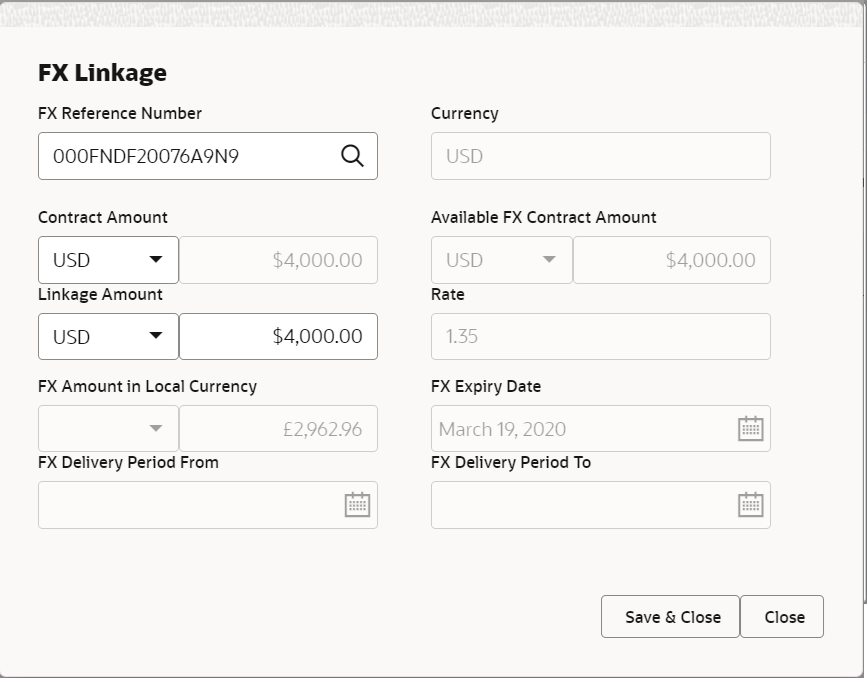2.2.3 Additional Details
This topic provides the systematic instructions to capture the additional details in Data Enrichment stage of Guarantee SBLC Advised - Claim Settlement Islamic process.
If any of the fields in the financial section of the pop up screen is checked then the limits and collaterals screen will be enabled.
- On Additional Details screen, click the 3 dots on any
Additional Details tile to view the details.
Figure 2-9 Additional Details
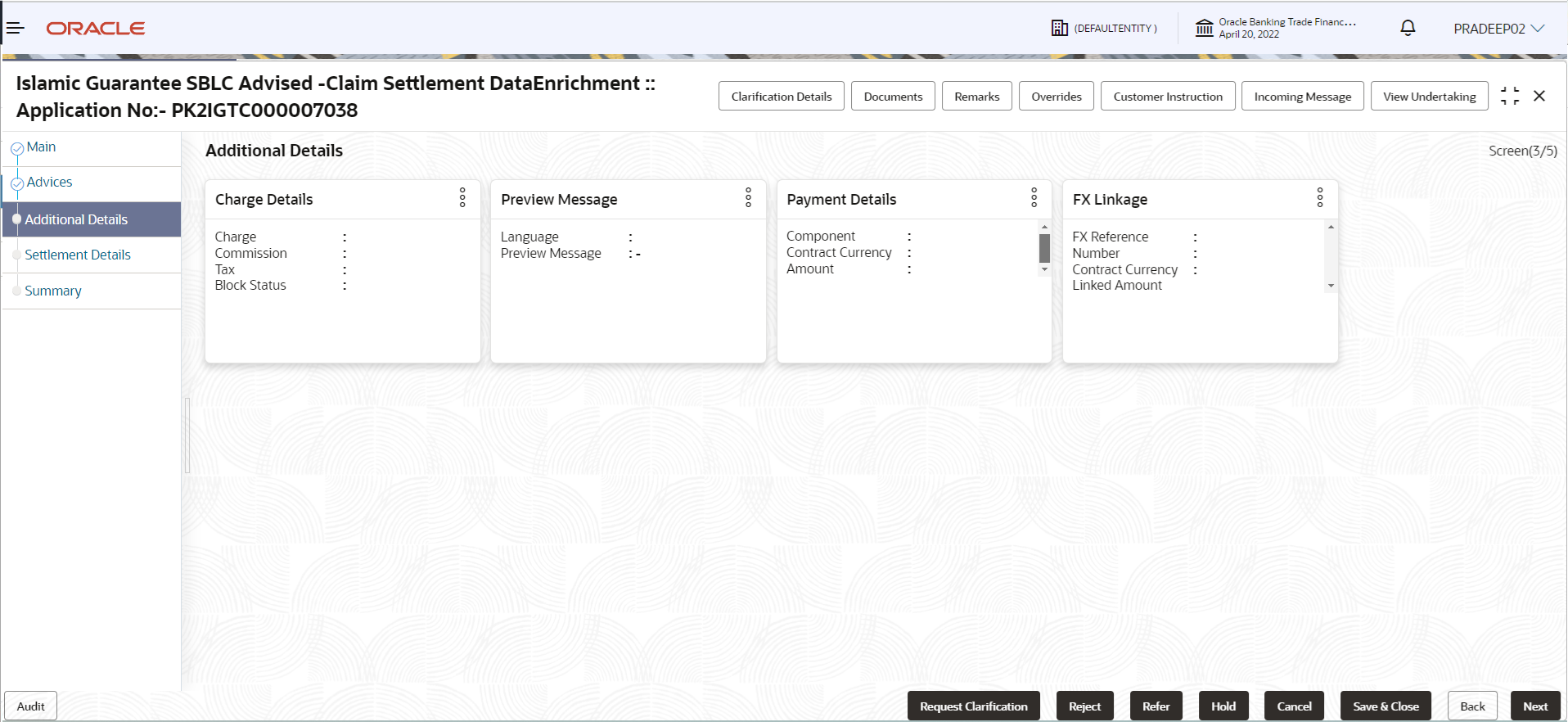
Description of the illustration deadditionaldetails.png - Click Charge Details to save the details and close the
screen.
Charge Details
This section displays charge details. On landing the additional tab, charges and tax if any will get defaulted. If default charges are available under the product, they should be defaulted here with values. If customer or customer group specific charges are maintained, then the same will be defaulted from back end system.
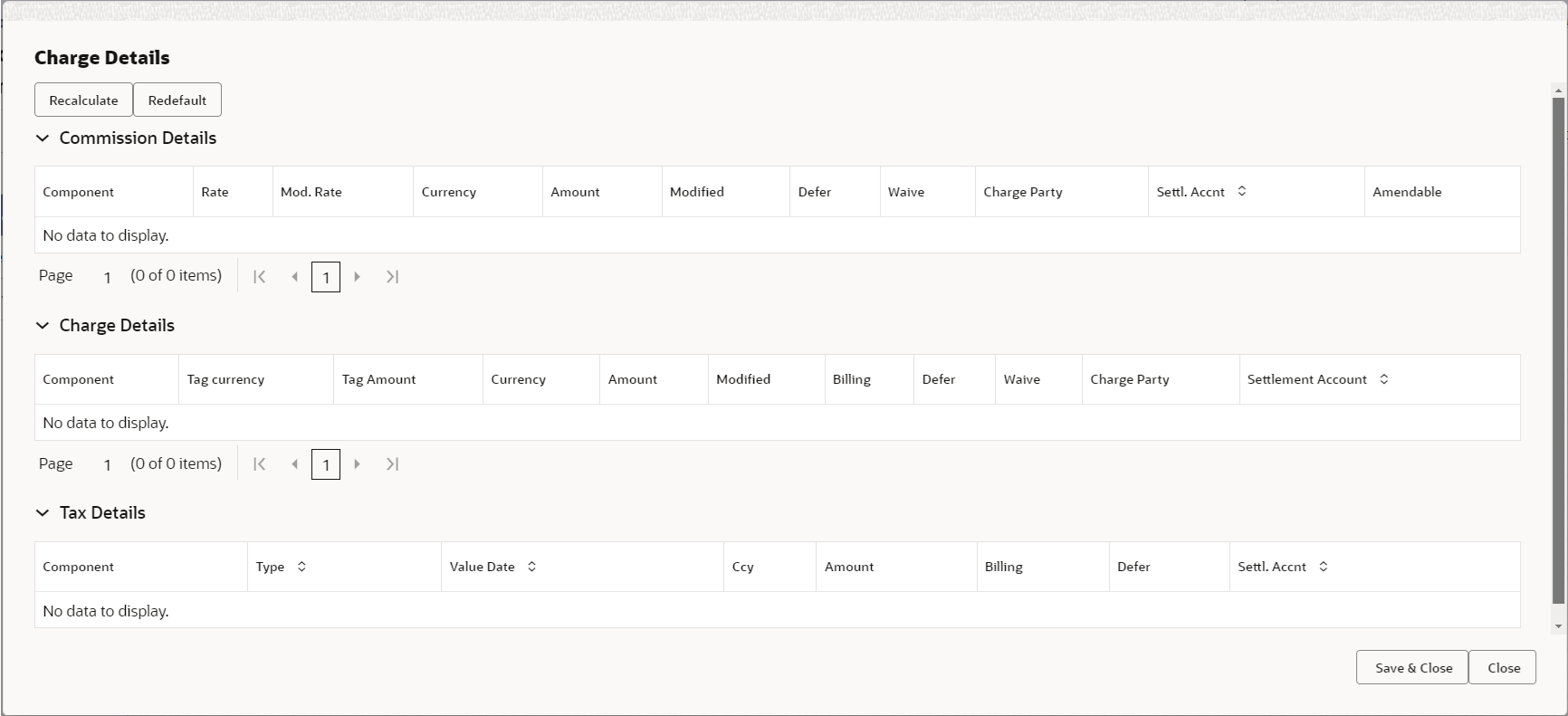
Description of the illustration dechargedetails.png
For more information on fields, refer to the field description table below.
Table 2-10 Charge Details - Field Description
Field Description Commission Details This section displays the commission details. All charges, commission and margin are collected from the counter-party by default.
Component This field displays the commission component. Rate This field displays the rate that is defaulted from product. The commission rate, if available in Back Office defaults in OBTFPMCS. The user is able to change the rate.
If flat commission is applicable, then commission amount defaulted from back office is modifiable by the user. Rate field will be blank and the user cannot modify the Rate field.
Mod. Rate From the default value, if the rate is changed the value gets updated in this field. Currency This field displays the currency in which the commission have to be collected. Amount This field displays the amount that is maintained under the product code. The commission rate, if available in Back Office defaults in OBTFPMCS. The user is able to change the rate, but not the commission amount directly. The amount gets modified based on the rate changed and the new amount is calculated in back office based on the new rate and is populated in OBTFPMCS.
If flat commission is applicable, then commission amount defaulted from back office is modifiable by the user. Rate field will be blank and the user cannot modify the Rate field.
Modified From the default value, if the amount is changed, the value gets updated in the modified amount field. Defer If enabled, charges/commissions has to be deferred and collected at any future step. Waive Based on the customer maintenance, the charges/commission can be marked for Billing or Defer. If the defaulted Commission is changed to defer or billing or waive, system must capture the user details and the modification details in the ‘Remarks’ place holder.
Charge Party Charge party is 'Applicant' by default. User can change the value to Beneficiary. Settl. Account The settlement account. Amendable Displays if the field is amendable or not. Charge Details This section displays theCharge Details. Component This field displays the charge component type. Tag Currency This field displays the tag currency in which the charges have to be collected. Tag Amount This field displays the tag amount that is maintained under the product code. Currency This field displays the currency in which the charges have to be collected. Amount This field displays the amount that is maintained under the product code. Modified From the default value, if the rate is changed or the amount is changed, the value gets updated in the modified amount field. Billing If charges are handled by separate billing engine, then by selecting billing the details to be available for billing engine for further processing. On simulation of charges/commission from Back Office, if any of the Charges/Commission component for the customer is ‘Billing’ enabled, ‘Billing’ toggle for that component should be automatically enabled in OBTFPMCS.
The user can not enable/disable the option, if it is de-selected by default.
This field is disabled, if ‘Defer’ toggle is enabled.
Defer If charges have to be deferred and collected at any future step, this check box has to be selected. On simulation of charges/commission from Back Office, if any of the Charges/Commission component for the customer is AR-AP tracking enabled, ‘Defer’ toggle for that component should be automatically checked in OBTFPMCS.
The user can enable/disable the option the check box. On de-selection the user has to click on ‘Recalculate’ charges button for re-simulation.
Waive Enble the toggle, if charges has to be waived. Based on the customer maintenance, the charges should be marked for Billing or for Defer.
This field is disabled, if Defer toggle is enabled.
Charge Party Charge party is applicant by default. User can change the value to beneficiary. Settlement Account Settlement account is defaulted by the system. The user can change the settlement account.
Tax Details Displays the tax details. The tax component is calculated based on the commission and defaults if maintained at product level. User cannot update tax details and any change in tax amount on account of modification of charges/ commission will be available on click of Re-Calculate button or on hand off to back-end system.
Component This field displays the tax component. Type This field displays the type of tax component. Value Date This field displays the value date of tax component. Ccy This field displays the currency in which the tax have to be collected. The tax currency is the same as the commission.
Amount This field displays the tax amount based on the percentage of commission maintained. You can edit the tax amount, if applicable.
Billing If taxes are handled by separate billing engine, then by selecting billing the details to be available for billing engine for further processing. This field is disabled, if ‘Defer’ toggle is enabled.
Defer If taxes have to be deferred and collected at any future step, this option has to be enabled. The user can enable/disable the option the check box. On de-selection the user has to click on ‘Recalculate’ charges button for re-simulation.
Settl. Account System defaults the settlement account. The user can modify the settlement account.
- Click Save and Close to save the details and close the
screen.Preview Message
The bank user can view a preview of the message and advice simulated from back office which is based on the guarantee Claim captured in the previous screen.
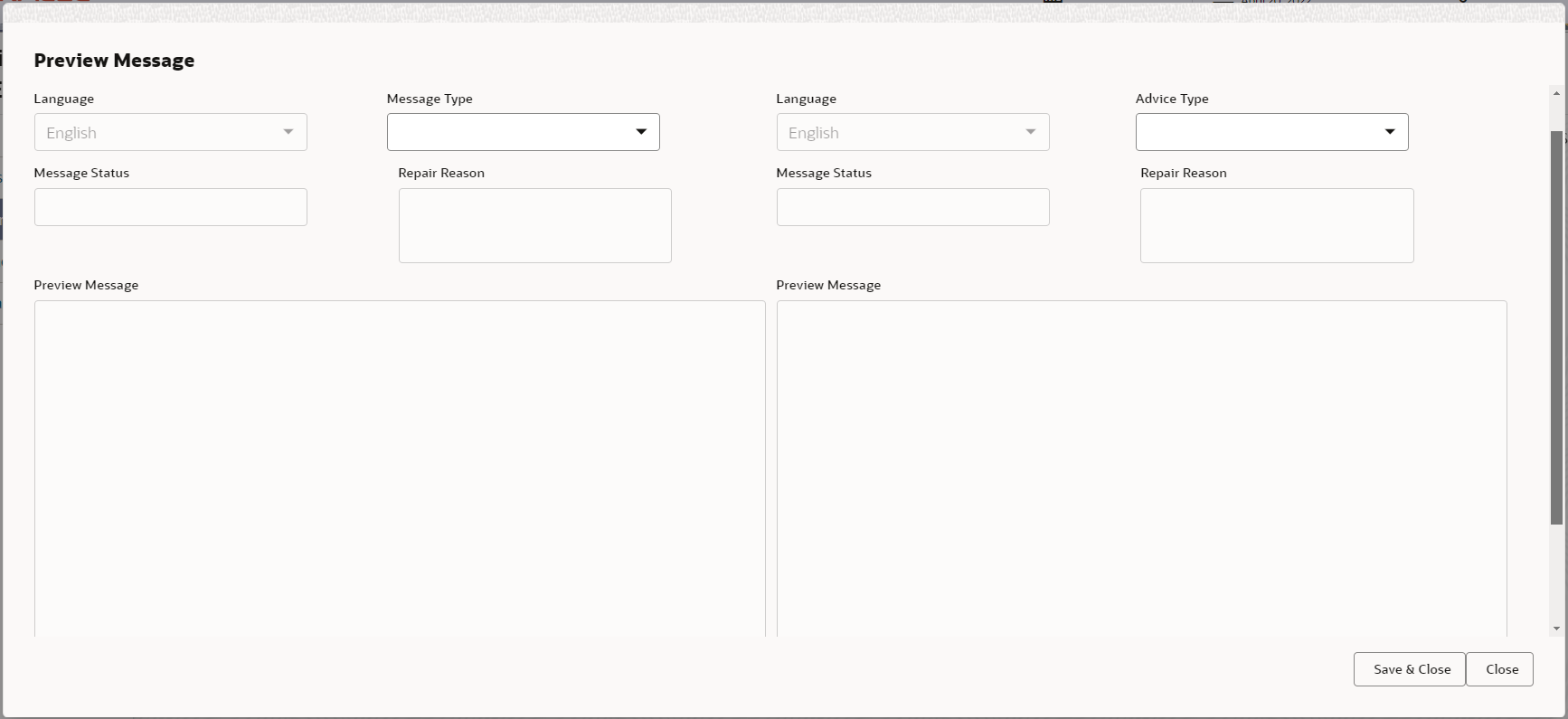
Description of the illustration depreviewmessage.pngFor more information on fields, refer to the field description table below.
Table 2-11 Preview Message - Field Description
Field Description Preview SWIFT Message Displays the preview of SWIFT Messages. Language Read only field. The language to preview the draft guarantee details.
English is set as default language for the preview.
Message Type Select the message type from the drop down. Message Status Read only field. Display the message status of draft message of guarantee details.
Repair Reason Read only field. Display the message repair reason of draft message of guarantee details.
Preview Message This field displays a preview of the draft message. Preview Mail Advice The preview message-mail advice is simulated from the back office and the user can view the message. Language Read only field. The language for the advice message.
English is set as default language for the preview.
Advice Type Select the advice type. Message Status Read only field. Display the message status of draft message of guarantee details.
Repair Reason Read only field. Display the message repair reason of draft message of guarantee details.
Preview Message This field displays a preview of advice. - Click Save and Close to save the details and close the
screen.Payment Details
As part of DE, the bank user can capture the payment details under a claim. The user can also be able to input the transaction details. The user can scrutinize the claim settlement request and input data as required.
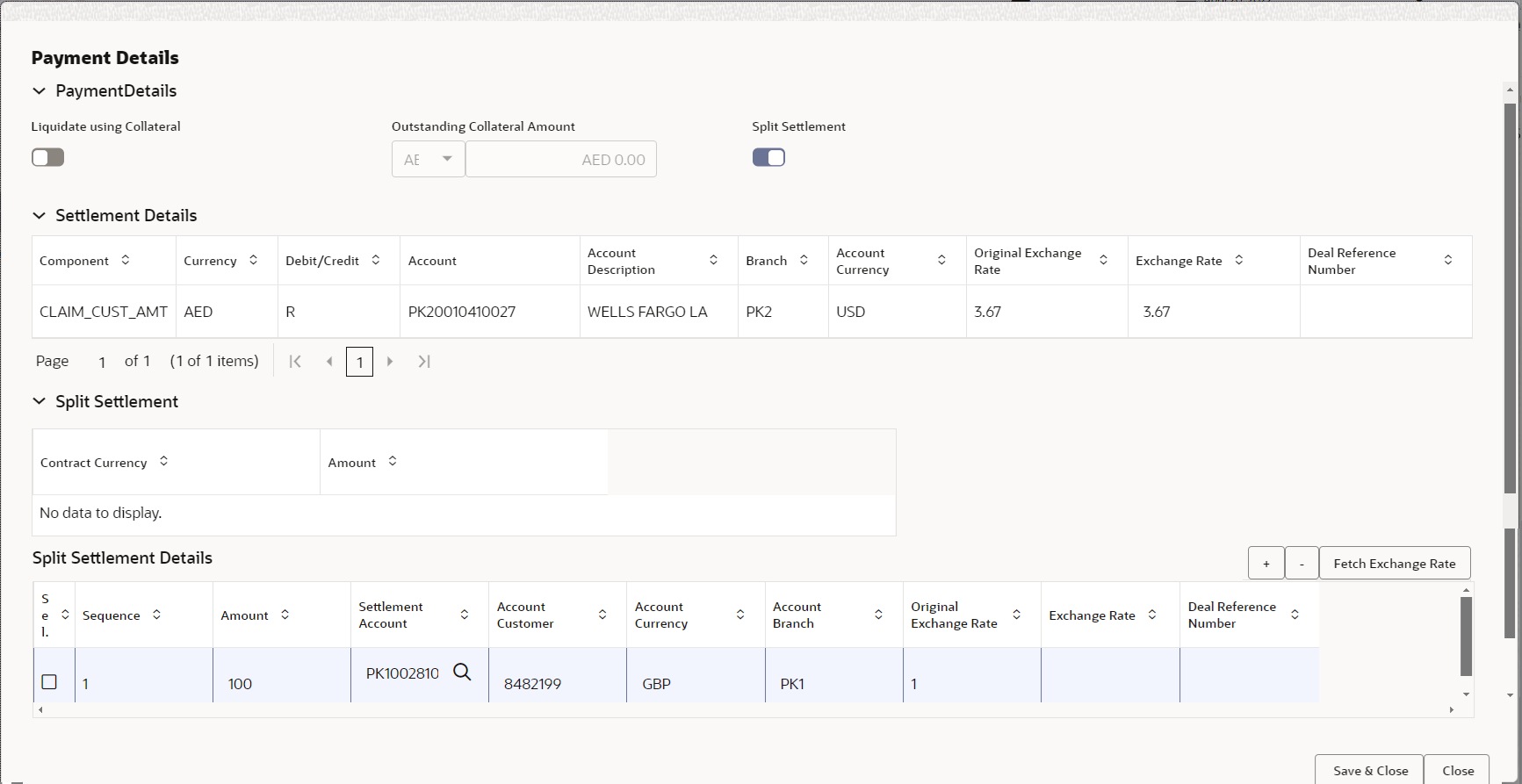
Description of the illustration depaymentdetails.pngFor more information on fields, refer to the field description table below.
Table 2-12 Payment Details - Field Description
Field Description Payment Details Specify the Payment Details. Liquidate using Collateral If the claim settlement has to be paid, via collateral the user has to select the Liquidate using collateral. User can liquidate using collateral only if collateral has been mapped at the time of Guarantee Issuance. In case collateral not mapped during issuance, user cannot add collaterals and use the same during liquidation.
Outstanding Collateral Amount Read Only field. System defaults the outstanding collateral amount (if mapped).
Settle Available Amount If partial settlement amount is debited from applicant and the balance have to be settled against loan, user to select this option. Split Settlement Enable the option to select more than one account for settlement (Split Settlement) for the liquidation of an import or export drawing or collection bill. Settlement Details Specify the Settlement Details. Component System defaults the component based on the product selected. Currency System defaults the currency for the component. Debit/Credit System defaults the debit/ credit value for the component. Account System defaults the customer account. User can modify the account.
Account Description System defaults the description of the customer’s account. Branch System defaults the branch of the customer’s account. Account Currency This field defaults the currency of the account. Original Exchange Rate System defaults the original exchange rate as simulated in split settlement details section. Exchange Rate System populates the exchange rate maintained. Deal Reference Number System defaults the exchange deal reference number. Split Settlement Below section appears, if user enables the Split Settlement option. Contract Currency System defaults the contract currency for the component. Amount The Amount for each component. This is populated from the transaction details of the guarantee issuance. Split Settlement Details Below section appears, if user enables the Split Settlement option. Click '+' plus icon to add new Split Settlement details.
Click - minus icon to delete the Split Settlement record.
Sel. Check box to select the split settlement details record/s. Seqence The sequence number is auto populated with the value, generated by the system. Amount Specify the amount for the split settlement. Settlement Account Click Search to search and select the settlement account from the look-up. Account Customer Displays the customer's account based on the settlement account selection. Account Currency Displays the customer's account currency based on the settlement account selection. Account Branch Displays the branch of the customer's account based on the settlement account selection. Original Exchange Rate System defaults the original exchange rate as simulated in settlement details section from OBTF on clicking the Fetch Exchange Rate button. Exchange Rate The exchange rate for the split settlement. Deal Reference Number The exchange deal reference number. - Click Save and Close to save the details and close the
screen.FX Linkage
This section enables the user to link the existing FX contract(s) to the Guarantee/SBLC Claim Settlement. FX Linkage call should be triggered on DE-submit.
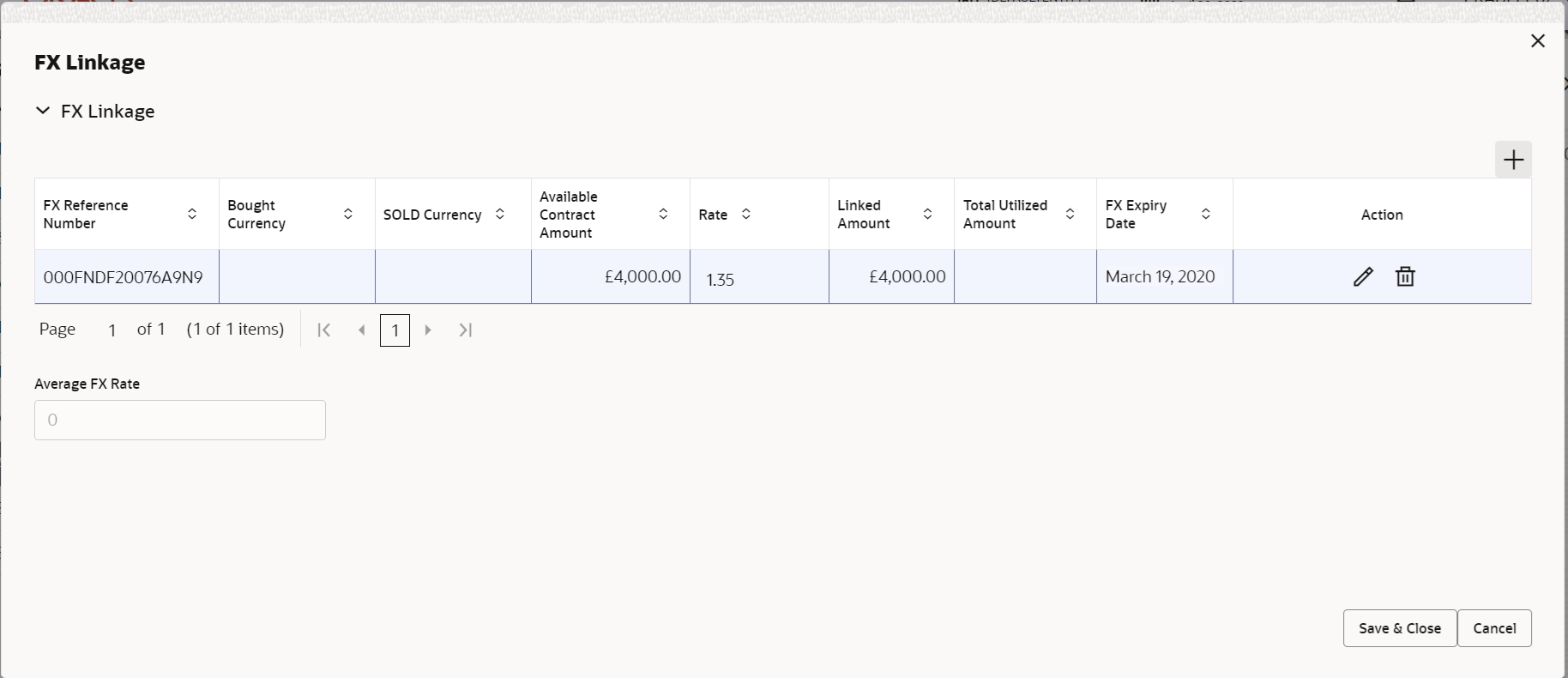
Description of the illustration fxlinkagedetails.pngFor more information on fields, refer to the field description table below.
Table 2-13 FX Linkage - Field Description
Field Description FX Linkage Click + to add multiple FX Details. Below fields are displayed on the FX linkage pop-up screen, if the user clicks plus icon.
FX Reference Number Click Search to search and select the FX contract reference number. On select and save and close, system defaults the available amount, bot currency, sold currency and rate. Forward FX Linkage available for selection at bill would be as follows,- Counterparty of the FX contract should be the counterparty of the Bill contract.
- Active Forward FX transactions authorized not marked for auto liquidation.
Bill contract currency should be BOT currency of the FX transaction in case of an export Bill or the SOLD currency in case of an Import Bill.
Currency This field displays the FX BOT currency from the linked FX contract. Contract Amount TThis field displays the FX BOT currency and Amount. The user can change the currency. Available FX Contract Amount This field displays the available FX contract amount. The value is from the “Available Amount” in FXDLINKG screen in OBTR.
Available Amount BOT currency and Amount is displayed.
Linkage Amount This field displays the amount available for linkage. The Linkage amount should default the LC Contract Currency and allowed to change the linkage amount alone.
The validation “Sum of Linked amount will not be greater than contract amount” or “Linkage amount will not be greater than the available amount for linkage” should be triggered on save of the FX linkage screen when trying to link the single FX or multiple FX.
Rate This field displays the rate at which the contract is booked. FX Amount in Local Currency This field displays the FX amount in local currency. The value is defaulted as FX BOT currency and Amount from FXDTRONL
FX Expiry Date This field displays the expiry date from the linked FX contract. FX Delivery Period - From This field displays the date from which the contract is valid for utilization. FX Delivery Period - To This field displays the date to which the contract is valid for utilization. FX Linkage grid Below fields appear in the FX linkage grid along with the above fields. Bought Currency This field displays the currency from the linked FX contract. Sold Currency This field displays the currency from the linked FX contract. Available Contract Amount Available amount will be FX contract amount minus the linked amount. Available amount for linkage should be greater than Zero. Linked Amount Sum of Linked amount will not be greater than LC contract amount. Linked amount will not be greater than the available amount for linkage.
Total Utilized Amount This field displays the total amount utilized against the corresponding linked FX. On query, both Utilized and Total Utilized amount holds the amount of latest version.
The value is Total Utilized Amount SOLD currency and Amount for Import LC/Guarantee Issuance from FXDLINKG .
Average FX Rate Multiple forward FX contract could be linked,and exchange rate of FX contract vary from each. Hence, effective exchange rate for bill would be arrived using weighted average method and it is utilized during purchase/negotiation/discount or liquidation of the bill. This will be populated in the Average FX Rate. Action Click Edit icon to edit the FX details. Click Delete icon to delete the FX details.
- Click Save and Close to save the details and close the screen.
- Click Next.The task will move to next data segment.
For more information on action buttons, refer to the field description table below.
Table 2-14 Additional Details - Action Buttons - Field Description
Field Description Clarification Details Clicking the button opens a detailed screen, user can see the clarification details in the window and the status will be ‘Clarification Requested’. Documents Click to View/Upload the required document. Application displays the mandatory and optional documents.
The user can view and input/view application details simultaneously.
When a user clicks on the uploaded document, Document window get opened and on clicking the view icon of the uploaded document, Application screen should get split into two. The one side of the document allows to view and on the other side allows to input/view the details in the applicationRemarks Specify any additional information regarding the Guarantee Advised - Claim Settlement Islamic. This information can be viewed by other users processing the request. Content from Remarks field should be handed off to Remarks field in Backend application.
Overrides Click to view the overrides accepted by the user. Customer Instruction Click to view/ input the following - Standard Instructions – In this section, the system will populate the details of Standard Instructions maintained for the customer. User will not be able to edit this.
- Transaction Level Instructions – In this section, OBTFPMCS user can input any Customer Instructions received as part of transaction processing. This section will be enabled only for customer initiated transactions.
Incoming Message Clicking this button allows the user to see the message in case of STP of incoming MT 767. View Undertaking Clicking this button allows the user to view the undertaking details. Request Clarification Clicking this button allows the user to submit the request for clarification to the “Trade Finance Portal” for the transactions that are initiated offline. Reject On click of Reject, user must select a Reject Reason from a list displayed by the system. Reject Codes are:
- R1- Documents missing
- R2- Signature Missing
- R3- Input Error
- R4- Insufficient Balance/Limits
- R5 - Others
Select a Reject code and give a Reject Description.
This reject reason will be available in the remarks window throughout the process.Refer Select a Refer Reason from the values displayed by the system. Refer Codes are:
- R1- Documents missing
- R2- Signature Missing
- R3- Input Error
- R4- Insufficient Balance/Limits
- R5 - Others
Hold The details provided will be saved and status will be on hold. User must update the remarks on the reason for holding the task. This option is used, if there are any pending information yet to be received from applicant.
Cancel Cancel the Data Enrichment stage inputs. The details updated in this stage are not saved. The task will be available in 'My Task' queue. Save & Close Save the details provided and holds the task in ‘My Task’ queue for further update. This option will not submit the request. Back Clicking on Back button, takes the user to the previous screen. Next On click of Next, system validates if all the mandatory fields have been captured. Necessary error and override messages to be displayed. On successful validation, system moves the task to the next data segment.
Parent topic: Data Enrichment
